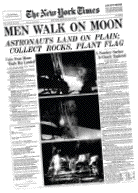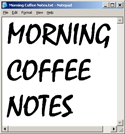
|
||||||||||||||||||||||||||||||||||||||||||||||||||||||||||||
|
The mess this creates makes me feel pretty queasy. I wish this were someone else's problem so I could watch from afar and think "There but for the grace of Murphy go I." But this time the problem is mine. I've done a fair amount of building on tr.im, and I have at least a few users, Nieman and Jay Rosen among them, who are using my tr.im-based tool. Really glad I didn't open up the 40twits app for broader use. If there are any url-shorteners out there that support the same functionality as tr.im, please post a comment here. And Twitter, when your DDoS problems are cleared up, please take a look at obviating the need for url-shorteners. This is a harbinger of much more serious problems down the road, should bit.ly prove not to be a profitable business, as tr.im has proven.
Now I'm going to add one, and provide a fantastic example. It's the title of this piece -- Narrate Your Work. Narrate Your Work is something I used to tell my team at UserLand Software, because we were a virtual team, with people in Seattle, Boston, Vancouver, Germany and California. But it would have applied even if we were all working in the same office. As a manager, I wanted to know where my people were, because if they were completing a project I needed to be thinking about their next steps and how their deliverables fit in with other stuff that was coming online. And if they were late I needed to understand why. We even developed technology for this, and Hutch Carpenter discovered the docs for it, and was excited about the discovery, and I was excited for his excitement. Brent Simmons, who was on our team at UserLand, went on to write NetNewsWire and other gems after leaving the company. Brent uses Twitter, to this day, to narrate his work. You'd have to ask Brent why he does it, but I'm glad he does. I like how his mind works, I learn from him. He's also a friend and a guy I respect, so I like to stay in touch, and this is one way to do it. Twitter is very much a Narrate Your Work environment, in addition to the many other things it is. In a way its question What Are You Doing? is what Narrate Your Work asks of you too. So that's what Narrate Your Work means. I wouldn't waste your time with all this theory unless I could show you how all this fits in with Rebooted News and the News System of the Future. Here's a recital of what happened. 1. As you may know, at roughly noon Eastern time yesterday a plane crashed into a helicopter over the Hudson River in NY, killing all nine people aboard both. 2. I was away from my computer when it happened, didn't check in until about an hour later, and on Twitter there was a mess of conflicting stories, and lots of individuals "breaking" the news even though it happened over an hour ago. 3. I clicked on the page of NYT editorial people on Twitter that I keep and I saw something very different, and this is the point of this story. I saw a news organization at work. Careful to say what they do and don't know. Informing each other on experience with similar stories in the past. Whether they were all reading all of the others' posts, I don't know. They were reading and passing on reports from other Twitter users, even those that didn't work at the Times. They were coordinating the work of a larger community than just people who work at the Times. 4. I took a snapshot of the page at that time so we could all look at this. Now why do I think this is so important? Because it's a big part of the future Rebooted News system, imho. Today's reporters don't think the public wants to see inside their process, but they are wrong about that. Many of us totally want to look inside and watch them at work for a variety of reasons:
2. But cable news isn't where it started, it started with the idea of news. It's not history or analysis, it's what's happening now. Think about how the Iran Hostage Crisis spawned Nightline and how the networks covered the Nixon resignation, or the moon landing or the assassinations of JFK, RFK and MLK. (In the recent spate of bios of Walter Cronkite I learned that he broadcast from the room he worked in at CBS News, not from a set on a stage. It's as if he was prepared to go on the air at any time and it wasn't appearances that mattered. At that time, to CBS, news was a functional thing.) 3. We also want to feel to be a part of the news process. Again this is something the networks are playing lip service to. But the Times people on Twitter aren't just pretending to use sources outside their own newsroom, they are actually doing it. And you can see it. 4. Weinberger says we should seek transparency, and of course I agree -- it's my theme song too. You can see real reporters dealing with a true breaking story not just a simulation of a breaking story, let their hair down and share everything they know with the world. This is the impulse of news, it's not about hiding things until they're ready, but when you know something for a fact, you want it out there as quickly as possible. And as long as something is clearly labeled as speculation it's every bit as true as a fully vetted fact. 5. Twitter is at least a dress rehearsal for the news system of the future. A key component of this system is that it is used both as the back room for narrating news work and for the finished delivered news product. It's this duality that makes electronic news vital. I first saw this in the LBBS and MORE software I did in the 80s, then in Manila in the 90s, and I believe we will see it in the news system that comes out of Twitter. You have two modes of viewing the content, the editorial view and the finished product view -- but it's important that the are just views on the same data, so when a change is made to one, it automatically appears in the other. This was the key concept in Manila's Edit This Page function. 6. Lenn Pryor at Microsoft figured this out a few years back when he started the Channel 9 website. Channel 9 is the audio channel on airplanes that allows you to listen to the cockpit conversation. Pryor set out to create that kind of experience for users of Microsoft products. Lenn is a creative guy who went on to work at Skype. He also coined the term unconference for the format we were using at BloggerCon. Update: The Times stays with the story. |
"The protoblogger." - NY Times.
"The father of modern-day content distribution." - PC World.
One of BusinessWeek's 25 Most Influential People on the Web. "Helped popularize blogging, podcasting and RSS." - Time.
"The father of blogging and RSS." - BBC.
"RSS was born in 1997 out of the confluence of Dave Winer's 'Really Simple Syndication' technology, used to push out blog updates, and Netscape's 'Rich Site Summary', which allowed users to create custom Netscape home pages with regularly updated data flows." - Tim O'Reilly.
My most recent trivia on Twitter. On This Day In: 2008 2007 2006 2005 2004 2003 2002 2001 2000 1999 1998 1997. |
|||||||||||||||||||||||||||||||||||||||||||||||||||||||||||
|
© Copyright 1997-2009 Dave Winer. Previous / Next |
||||||||||||||||||||||||||||||||||||||||||||||||||||||||||||
 I've done a lot of building on the tr.im url-shortener, as have quite a few other developers. They just
I've done a lot of building on the tr.im url-shortener, as have quite a few other developers. They just  Over the years I've seen ideas that show up over and over in various different forms, and when we discover one, we give it a name. Examples. Jay Rosen came up with
Over the years I've seen ideas that show up over and over in various different forms, and when we discover one, we give it a name. Examples. Jay Rosen came up with  1. We thirst for instantaneous real-time news. The cable networks have been simulating it for decades, but not delivering very often. Go back to the Gulf War, and how we were all glued to CNN watching for any hint of new information. It became an obsession that was repeated in the 2000 election and in the aftermath of 9-11. Now we try to grab for that sense of immediacy whenever possible, and they market to us on that basis even naming their show The Situation Room, when it is nothing of the sort.
1. We thirst for instantaneous real-time news. The cable networks have been simulating it for decades, but not delivering very often. Go back to the Gulf War, and how we were all glued to CNN watching for any hint of new information. It became an obsession that was repeated in the 2000 election and in the aftermath of 9-11. Now we try to grab for that sense of immediacy whenever possible, and they market to us on that basis even naming their show The Situation Room, when it is nothing of the sort. 

